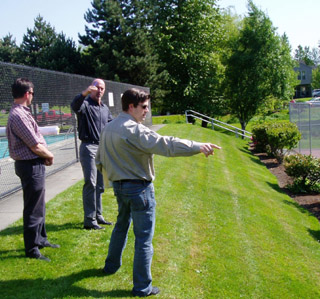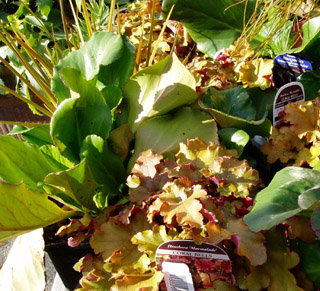
Surveys
DJC.COM
April 17, 2008
Landscape design inspiration beyond the office walls
Studio 342 Landscape Architecture

Fleckenstein
|

Wichers
|
One of the most fascinating aspects of landscape architecture is that every site and every project is unique. Topography, sun exposure, a client’s program elements and even a client’s personality will all vary greatly from project to project.
Accordingly, a landscape architect’s design response should take into account those differences, resulting in a wide variety of designs. However, as part of a wider industry that places high importance on the lasting success of past projects, it can be easy for designers to fall into the trap of repeating their past successes, much to the detriment of fresh and innovative design. It is also easy to lose one’s creative spark amidst the daily grind of office work.
Landscape architects are expected to continually generate new design ideas, yet often rely on the same old sources of inspiration. When you consider that many designers are only exposed to the same office environment, co-workers or other common sources of inspiration day after day, it’s no wonder that those inspirational wells run dry, leading to overused and stale design solutions.
To ensure that the best design is being achieved, it is important to develop and encourage strategies that go beyond the design office walls that will inspire us as landscape architects, strengthen our design abilities and expand our palette of ideas. The following three strategies are ones that Studio 342 Landscape Architecture encourages to continually develop skills that lead to great design.
Design charettes

Photos courtesy of Studio 342 Landscape Architecture On-site charettes help landscape architects, architects and owners envision outdoor spaces. |
A charette is a collaborative brainstorming session involving multiple people used to generate solutions to design problems. Charettes not only produce many design options to evaluate, but they also draw on the strengths and experiences of each contributor. If one believes the saying “two heads are better than one,” then it follows that a design solution produced and tested by multiple people will be stronger than one that wasn’t.
Charette participants can vary from project to project. Some design offices emphasize a charette process that includes many people, ranging from other design professionals to clients. Inviting clients to a charette can increase their interest and knowledge of the design process. Often, the owner of a property has the most insightful knowledge of a site, which can be invaluable to a designer or design team.
Another strategy would be including possible users of a site, like inviting children to a playground design charette. The ideas created and the system of checks and balances that naturally occur during a charette only lead to stronger design solutions.
Studio 342 staff recently participated in an on-site charette where architects, landscape architects, interior designers, construction managers, the project owners, and future users all envisioned indoor and outdoor spaces of a new community, resulting in a strong conceptual design and an inspired design team.
Academia

Experimenting with new plant combinations at nurseries can inspire design ideas. |
The world of academia is often defined by cutting-edge research, and in design fields, a certain lack of real-world restrictions on design studio projects. It can be a great resource for design professionals who find their design solutions stifled by actual projects with real clients and budgets. Playing an active role at universities or community colleges can benefit design professionals by inspiring them as designers and bettering their design communication skills.
One way for design professionals to introduce themselves to the academia world is to participate in reviews of student design projects. Without those real-world restrictions, students have the freedom to push design boundaries and introduce previously undiscovered design ideas. These unbridled design solutions and ideas can help inspire design professionals to look at a project from a new perspective or flush out “wide-eyed” concepts to practical solutions.
Many studios often have a research element to find relevant case studies or new trends relating to the project. The research done by the class may introduce professionals to a case study or aspect of a project they were unaware of, thereby increasing their design knowledge. Reviewing student work is not only part of the educational process for the student, but it can teach a professional how to better evaluate and communicate design ideas.
Some designers return to academia as teachers, offering students knowledge learned through real-world experience. Teaching will reinforce and expand design professionals’ knowledge of a subject, as they research trends and current developments related to their field. As they practice sharing their research and expertise with students, they will further improve upon their own professional design communication abilities.
The academic world of design is an environment to learn from others, experiment with new techniques, research new ideas and philosophies, and encourage creativity.
Nursery visits
A big part of landscape architects’ jobs is to incorporate creative planting design into their projects. Over time, many professionals may come to rely on tried and true plant palettes and combinations. While this strategy of relying on what’s worked in the past is a proven success, it can become repetitive, and lack the creativity and inspiration it once had.
With all the new plant cultivars and varieties being developed, it is difficult for reference publications to keep up and provide information for new plants. Design offices can stay current with new nursery developments and trends with regular visits to local nurseries. Not only will regular field trips to a nursery introduce designers to new plants, but also they will reinforce the seasonal changes to plants they are already familiar with.
Noting names, varieties and taking photos of newly discovered plants is a great way to keep an office’s plant palette updated and continually injected with new and exciting options.
A simple exercise to complete during a nursery visit is to collect a variety of plants and place them in different arrangements to test new design combinations. This experimentation may inspire a new planting theme for a project not at a client’s expense.
Encouraging participation in design charettes, academia and seasonal nursery visits are simple strategies that can help promote the development of fresh design ideas and expand the various palettes used in landscape architecture. They help get designers out of the office and can ignite a creative spark for fresh and inspired design solutions.
Jamie Fleckenstein and Chad Wichers are the founders and principals of Seattle’s Studio 342 Landscape Architecture. Both are registered landscape architects and faculty at the University of Washington’s Department of Landscape Architecture.
Other Stories:
- Seattle designer has a renaissance in North Dakota
- Easy steps to successful wetland mitigations
- Are meadows the hot new landscape trend?
- Use a site analysis to value rural conservation lands
Copyright ©2009 Seattle Daily Journal and DJC.COM.
Comments? Questions? Contact us.